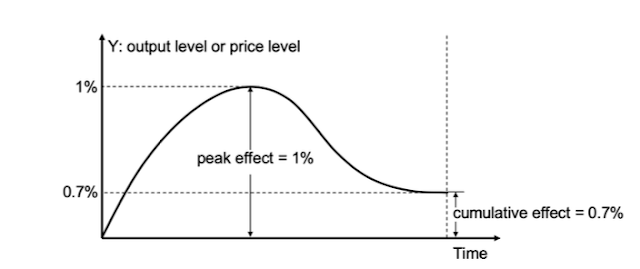It always struck me that research inside the Fed seems to produce answers closer to the views of Fed officials than does research outside of the Fed. Perhaps my experience of reading a speech by Ben Bernanke one morning and attending a workshop by a Fed economist that found exactly his guess of the (implausibly large, to me) effects of QE that afternoon colored my views.
In "Fifty Shades of QE:" Brian Fabo, Martina Jančoková, Elisabeth Kempf, and Luboš Pástor quantify this tendency:
...central bank papers report larger effects of QE on output and inflation. Central bankers are also more likely to report significant effects of QE on output and to use more positive language in the abstract. Central bankers who report larger QE effects on output experience more favorable career outcomes. A survey of central banks reveals substantial involvement of bank management in research production.
Figure 5 gives some sense of the result:
The "standardized" results scale the size of the QE programs to make sure authors are not comparing QE episodes with different sizes, and are thus a better comparison. The "peak" vs "cumulative" effects mean this:
One of my frustration with central banker speeches on this point has been their confusion of announcement, impact, peak, and cumulative effects. The, price pressure, portfolio imbalance, segmented market view of QE might make sense of a temporary impact, but central bankers regard estimates of the announcement or impact effects as estimates of a permanent effect of QE.
Summarizing regressions with various controls
...changing the share of central bank authors from zero to 100% is associated with a 0.723 percentage points larger peak effect and a 0.512 percentage points larger cumulative effect on output (Panel A). These are sizable magnitudes relative to the unconditional means of 1.57% and 0.87%, respectively, from Table 2. The results based on standardized effects, reported in Panel B, are also economically large. Going from zero to 100% central bank authors corresponds to a 0.152 percentage points larger standardized peak effect: an increase by two thirds of the unconditional mean. For the standardized cumulative effect, the difference is 0.122 percentage points, equivalent to 87% of the unconditional mean.
The paper summarizes several mechanisms, but it's not hard to imagine subtle and individually benign why a researcher in any business might want to work hard to support the official position of the institution he or she works for, or positions that make the institution seem more powerful, or might just want to spend more time on research that seems to be going that way. Institutions can be systemically biased even if individually unbiased. Many friends tell me that there is no pressure to conform to the party line.
An institutional view is not necessarily a bad thing either, when institutions compete. There's not much woke anti-capitalism coming out of Hoover. We're allowed to do whatever we want, but it's not a very productive environment for that sort of work. But there are plenty of other institutions to advance such causes, even at Stanford, and we compete in the marketplace of ideas.
The huge central bank and international institution research staffs are a much less competitive environment, especially for the ears of policy officials. And policy officials especially should be aware of the great danger that their advisers tell them what the advisers think they want to hear. If I were Fed chair, I would assign someone to be Devil's advocate at every meeting, his/her job to say "this is all BS."
International central banks are headed off to stop climate change by de-funding fossil fuels. The Fed is headlong becoming involved in inequality, social justice, and race. The IMF is also rushing headlong to these issues, advocating climate and inequality concerns as top priorities for central banks. The danger of in-the-bubble, what-the-boss-wants-to-hear research in these contentious and politicized areas seems even stronger, and the incentives against questioning the in-the-bubble consensus larger when there is more virtue to signal and opprobrium to avoid than on the question whether asset purchases raise GDP.
A suggestion for the authors, confirmed by talks with central bank staff assigned these unpleasant tasks: For your next paper, evaluate in vs. out of central bank research on measuring the risk of climate change to "financial stability."
from The Grumpy Economist https://ift.tt/3kUjFPD



0 comments:
Post a Comment